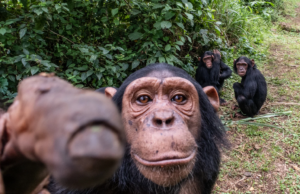BONOBOS: NEW SPECIES OR ADAPTED CHIMPANZEES?
For the fact that they live in an isolated region of Congo, located between two rivers, the access to these primates was always very strict and some researchers had became renowned by being the pioneers in studying them.
In our day-by-day with chimpanzees, we started to realize that the characteristics classified as exclusive of bonobos are also presented in the world of chimpanzees. This makes us think about the criteria of distinction of bonobos and chimpanzees.
Is it possible that only they have a matriarcal societyω Is it possible that they are the only ones who treat unsolved questions with \’promiscuous sex\’ω What can we say about Dolores and Samantha, who live together and also do GG-Rubbingω Would they be the only ones that copulate in missionary positionω What can we say about Billy Jr. and Dolores, who are chimpanzees and copulate in this positionω
Another myth – that they are pacifists and friendly – is not sustained either, because there are reports about fights between groups and the identification of other primates hunting habits, as it is shown in a work developed by Martin Surbeck and Gottfried Hohmann. As it has been published in a newspaper, “peace and love chimpanzee attacks and eats little monkeys”. We can see that the classification of bonobos is not that easy. Some behavior standards openly described in literature are not exclusivity of bonobos, as mister Frans de Waal always assumed.
According to biology, a species is defined as a group of individuals that has the same genetic characteristics, being able to mate in natural conditions and generate fertile descendents. Then, the fact that these primates group lives isolated, couldn\’t it be an adaptation to the environmentω The fact that they are more biped than chimpanzees, couldn\’t it be an adaptation to the environment in which they liveω For instance, a locomotion way that offers a better visualization of preys/predators in the vegetationω
Would it be the tiny behavioral and morphological differences enough to classify them as a new speciesω It is a fact that bonobos have bigger limbs, are more bipeds, use to spend more time than chimpanzees on the trees and the one who usually define the rules in a group is the female. But we, humans, do not differ in behavior and morphology according to the region we liveω Don\’t Asians have a different lookω Africans do not have more melanin in the skinω Aren\’t Europeans whiter and tallerω Besides, how many families have their orders defined by womenω Even though, aren\’t we all Homo sapiensω And is not each one of this race result of the adaptation to the environment one livesω
As a biologist and enthusiast of the subject, I believe that bonobos are nothing more than chimpanzees in a smaller size. After all, we have Indians, Africans, Arians, Pigmies, to sum it up, a great diversity in human species, with different habits, cultures and biotypes, but everyone is classified as Homo sapiens. Then, what would be the reason to classify bonobos and chimpanzees distinctly, considering that there are very few differences and the similarities are very near to each other. Or it would be the case that we review the concept of Homo sapiens and classify each race according to their traditions and tiny differencesω
The discussion is opened.
Msc. Luiz Fernando Leal Padulla
Biologist

 Español
Español
 Português
Português








